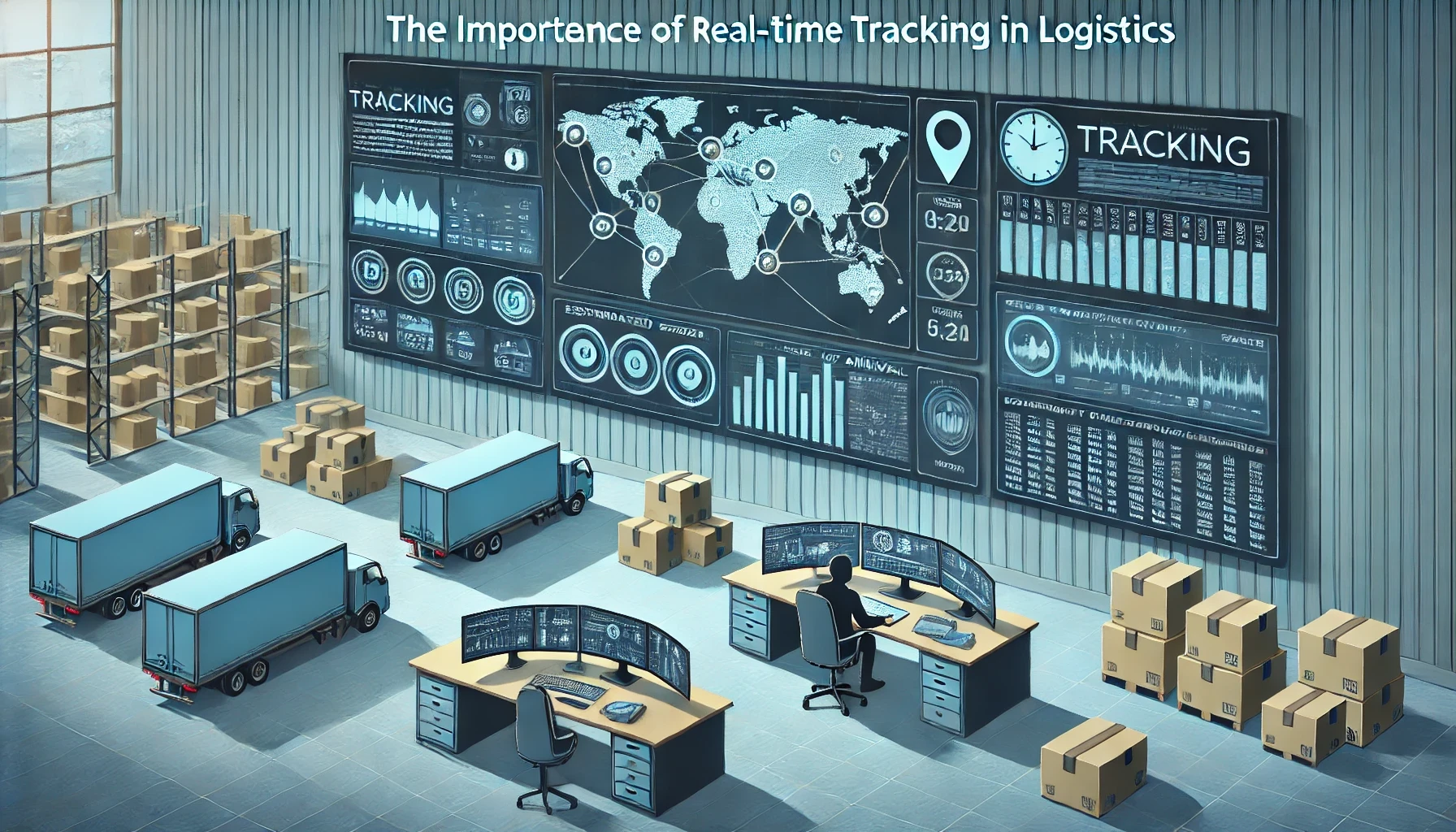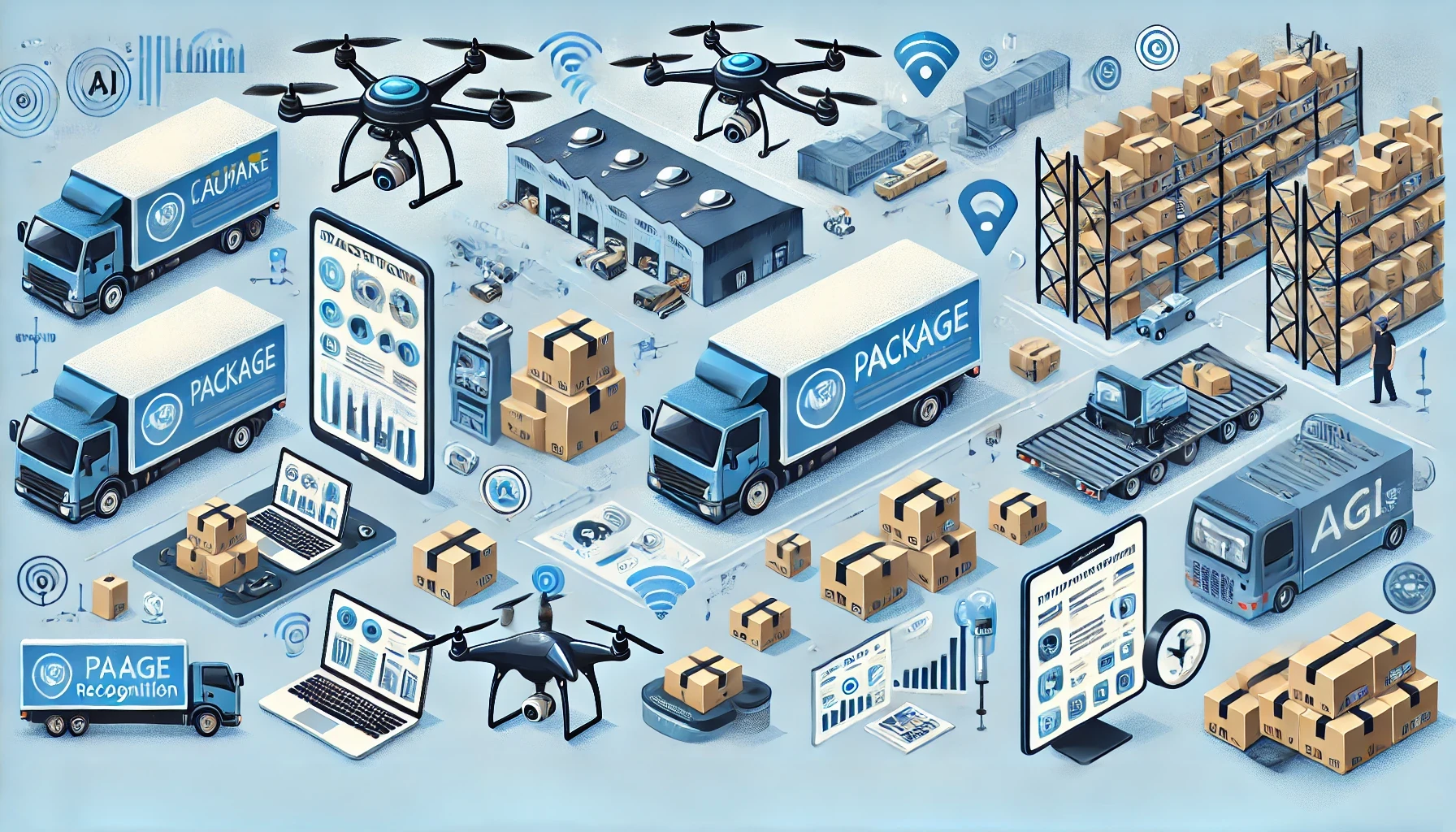Streamline Logistics Operations with AI-Powered Image Recognition for Real-Time Tracking
Introduction
In today's interconnected and fast-paced global marketplace, the logistics industry stands as a critical backbone supporting the flow of goods and services. The surge in e-commerce, accelerated by technological advancements and changes in consumer behavior, has dramatically increased the volume and complexity of supply chains. According to the World Economic Forum, global trade volume is projected to grow by 2.3% in 2024 and 3.3% in 2025 – more than double the 1% growth seen in 2023, further intensifying the demand for efficient logistics solutions.
Traditional logistics operations, heavily reliant on manual processes and outdated tracking methods, are struggling to keep up with the escalating expectations for speed, transparency and accuracy. Inefficiencies in tracking and inventory management not only lead to increased operational costs but also negatively impact customer satisfaction and brand reputation.
Amidst these challenges, AI-powered image recognition emerges as a transformative technology offering innovative solutions. By leveraging artificial intelligence and advanced image processing techniques, logistics companies can achieve real-time tracking, automate inventory management and enhance overall operational efficiency.
This article delves into how AI-powered image recognition is revolutionizing logistics operations. We will explore the technology's fundamentals, its practical applications, benefits, challenges and its promising future in reshaping the logistics landscape.
The Importance of Real-Time Tracking in Logistics
Evolution of Logistics and Supply Chain Management
The logistics industry has evolved significantly over the past few decades. Initially, logistics operations were manual, with paper-based documentation and rudimentary tracking methods. The introduction of barcode technology in the 1970s marked a significant advancement, enabling faster data entry and reducing errors. Subsequently, the 1990s saw the adoption of Radio Frequency Identification (RFID) technology, allowing for non-contact reading of tags attached to items.
However, the explosion of e-commerce in the 21st century, coupled with globalization, has introduced unprecedented complexity into supply chains. Customers now expect same-day or next-day deliveries, real-time tracking updates and high levels of service personalization. This shift necessitates logistics operations that are not only efficient but also highly adaptable and responsive.
Digital transformation in logistics has become imperative. The integration of advanced technologies such as the Internet of Things (IoT), Big Data analytics and Artificial Intelligence (AI) is reshaping how goods are moved, stored and delivered. Among these, AI-powered image recognition stands out for its potential to significantly enhance tracking and inventory management processes.
Challenges with Traditional Tracking Methods
Despite technological advancements, many logistics operations still rely on traditional tracking methods that present several challenges:
Manual Data Entry Errors: Human involvement in data entry increases the risk of errors. Mislabeling, incorrect data input and oversight can lead to misplaced shipments and inventory discrepancies.
Delayed Information Flow: Traditional systems often update tracking information at specific intervals rather than in real-time. This delay hampers the ability to respond promptly to issues such as shipment delays, routing errors, or inventory shortages.
Limited Supply Chain Visibility: A lack of end-to-end visibility makes it difficult to monitor goods throughout the entire supply chain. This limitation can result in inefficiencies, increased lead times and challenges in demand forecasting.
High Operational Costs: Inefficient processes contribute to higher labor costs, increased fuel consumption due to suboptimal routing and additional expenses from expedited shipping to rectify delays.
Customer Dissatisfaction: Inadequate tracking and delayed deliveries negatively impact customer experience, leading to potential loss of business and damage to brand reputation.
These challenges highlight the need for innovative solutions that can enhance tracking accuracy, provide real-time updates and streamline logistics operations.
Understanding AI-Powered Image Recognition
What is AI Image Recognition?
AI image recognition, also known as computer vision, is a field of artificial intelligence that trains computers to interpret and understand the visual world. By using digital images from cameras and videos, along with deep learning models, machines can accurately identify and classify objects—and then react to what they "see."
In logistics, AI image recognition can be applied to:
Package Identification: Automatically recognizing packages, labels and barcodes without manual scanning.
Inventory Monitoring: Observing stock levels and detecting when items need replenishment.
Quality Control: Identifying damaged goods or packaging to prevent faulty products from reaching customers.
Technologies Behind Image Recognition
AI-powered image recognition relies on several advanced technologies:
Machine Learning (ML): A subset of AI focusing on the development of algorithms that allow computers to learn from and make predictions based on data. ML models improve over time as they are exposed to more data.
Deep Learning: A branch of ML that uses neural networks with multiple layers (deep neural networks) to analyze various factors of data. In image recognition, deep learning models can detect intricate patterns and features within images.
Convolutional Neural Networks (CNNs): Specialized deep learning models designed to process pixel data. CNNs are highly effective for image classification and recognition tasks due to their ability to capture spatial hierarchies in images.
Optical Character Recognition (OCR): A technology that converts different types of documents, such as scanned paper documents or PDFs, into editable and searchable data. In logistics, OCR is used to read text from images of shipping labels, invoices and other documents.
Object Detection and Localization: Techniques that not only identify objects within an image but also determine their location and size. This is crucial for applications like sorting and quality inspection.
By integrating these technologies, AI image recognition systems can perform complex tasks such as detecting anomalies, classifying objects and making autonomous decisions in real-time.
Benefits of AI Image Recognition in Logistics Operations
Enhanced Accuracy and Efficiency
Implementing AI-powered image recognition leads to significant improvements in operational accuracy and efficiency:
Reduction in Human Error: Automation of data capture eliminates mistakes associated with manual data entry. This accuracy is critical in maintaining inventory integrity and ensuring that shipments are correctly routed.
Faster Processing Times: AI systems can process images and extract relevant data much faster than humans. This speed accelerates operations such as sorting, loading and unloading, contributing to increased throughput.
Improved Quality Control: Automated inspection of goods can detect defects or damages that may be overlooked by human inspectors, ensuring that only quality products reach customers.
Real-Time Data Availability
Real-time data is a game-changer in logistics:
Immediate Tracking Updates: AI systems provide up-to-the-minute information on the location and status of shipments, enabling proactive management of the supply chain.
Dynamic Decision-Making: Access to real-time data allows for swift responses to unforeseen events, such as rerouting shipments due to traffic conditions or addressing delays caused by equipment malfunctions.
Enhanced Transparency: Both businesses and customers benefit from increased visibility into logistics operations, fostering trust and satisfaction.
Cost Savings
Cost reduction is a significant benefit of AI implementation:
Labor Cost Reduction: Automating repetitive tasks reduces the need for manual labor, allowing employees to focus on more strategic activities.
Decreased Operational Expenses: Improved efficiency and accuracy lead to lower costs associated with errors, delays and expedited shipping.
Optimized Resource Utilization: AI systems help in better planning and utilization of resources like warehouse space, vehicles and equipment.
According to a report by McKinsey & Company, AI-driven supply chain management can lead to a reduction in logistics costs by 15% and inventory levels by 35%.
Improved Customer Satisfaction
Customer experience is enhanced through:
Reliable Deliveries: Increased accuracy and efficiency ensure that deliveries are made on time and to the correct locations.
Enhanced Communication: Real-time tracking information can be shared with customers, keeping them informed about their shipments.
Personalization: AI systems can analyze customer data to provide personalized services, such as delivery time preferences or packaging options.
Improved customer satisfaction leads to increased loyalty and repeat business, providing a competitive advantage in the market.
Practical Applications of AI Image Recognition in Logistics
Inventory Management
Effective inventory management is critical for meeting customer demands without overstocking. AI image recognition contributes by:
Automated Stock Monitoring: Cameras and sensors equipped with AI can continuously monitor inventory levels on shelves or in storage areas, updating records in real-time.
Predictive Restocking: AI algorithms can predict when stock levels will deplete based on historical data and trends, prompting timely restocking.
Minimizing Shrinkage: Detecting misplaced items or potential theft by monitoring inventory movements.
For instance, retailers are using shelf-scanning robots that employ AI to check stock levels, price and misplaced items, significantly improving inventory accuracy.
Supply Chain Visibility
End-to-end visibility enhances the ability to manage and optimize the supply chain:
Tracking Shipments: AI image recognition can monitor goods at every stage, from production to delivery, ensuring they follow the correct path.
Identifying Bottlenecks: By analyzing data from various points in the supply chain, AI can identify delays or inefficiencies that need addressing.
Compliance and Security: Verifying that shipments comply with regulations and detecting unauthorized access or tampering.
Advanced AI platforms provide comprehensive visibility into supply chain operations, enabling better planning and risk management.
Automated Sorting and Handling
Automation in sorting and handling improves speed and reduces errors:
Robotic Sorting Systems: Robots equipped with AI vision systems can sort packages based on size, destination, or priority without human intervention.
Dynamic Routing: AI can determine the most efficient routing for packages within a facility, reducing congestion and handling times.
Damage Detection: Identifying damaged packages before they proceed further in the supply chain, preventing customer dissatisfaction.
Logistics companies are utilizing AI-powered robots in their warehouses, achieving high levels of automation and efficiency in order fulfillment.
Fleet Management
Managing a fleet efficiently is essential for timely deliveries:
Driver Monitoring: AI systems analyze driver behavior, promoting safe driving practices and reducing accidents.
Vehicle Maintenance: Image recognition can detect vehicle wear and tear, scheduling maintenance before breakdowns occur.
Cargo Monitoring: Ensuring that goods are properly loaded and secured and that environmental conditions are maintained for sensitive products.
AI solutions in fleet management result in reduced fuel consumption and improved delivery times.
Challenges and Considerations in Implementation
Technical Challenges
Implementing AI-powered image recognition comes with technical hurdles:
Integration with Existing Systems: Many logistics companies operate legacy systems that may not be compatible with new AI technologies. Integrating AI requires careful planning and often, significant system overhauls.
Data Quality and Quantity: AI systems rely on large amounts of high-quality data to function effectively. Inadequate or poor-quality data can lead to inaccurate results.
Infrastructure Requirements: Implementing AI requires robust IT infrastructure, including high-speed networks, cloud computing resources and secure data storage solutions.
Scalability: Ensuring that AI systems can scale with the business is crucial. This requires flexible architectures and platforms that can handle increasing data volumes and processing demands.
Data Privacy and Security
Handling sensitive data introduces concerns:
Compliance with Regulations: Laws like the General Data Protection Regulation (GDPR) in the EU impose strict rules on how personal data is collected, processed and stored.
Cybersecurity Risks: AI systems can be targets for cyberattacks. Protecting data from breaches is essential to maintain trust and avoid legal repercussions.
Ethical Considerations: Companies must ensure that AI systems do not infringe on individual privacy rights or contribute to biased decision-making.
Implementing strong data governance policies and investing in cybersecurity measures are critical steps in mitigating these risks.
Workforce Adaptation
The human element is vital in successful AI integration:
Training and Development: Employees need to be trained to work with new AI systems. This may involve upskilling staff in data analysis, AI system operation and maintenance.
Change Management: Implementing AI can change job roles and processes. Effective communication and involvement of employees in the transition process help in reducing resistance.
Addressing Job Displacement: Automation can lead to concerns about job losses. Companies should consider strategies for redeploying staff to areas where human skills are essential, such as customer service or strategic planning.
By proactively managing workforce adaptation, companies can ensure that employees are engaged and that the benefits of AI implementation are fully realized.
The Future of Logistics with AI Image Recognition
Emerging Trends
The logistics industry is poised for further transformation:
Hyperautomation: Combining AI with other technologies like robotic process automation (RPA) to automate complex processes end-to-end.
Edge Computing: Processing data closer to the source (e.g., in warehouses or vehicles) reduces latency, enabling real-time decision-making without reliance on cloud connectivity.
Augmented Reality (AR): Integrating AI with AR devices to assist workers in tasks like picking and packing, providing visual cues and instructions.
Integration with Other Technologies
Synergies with other technologies amplify AI's impact:
Internet of Things (IoT): IoT devices collect data from physical assets, which AI systems can analyze to optimize operations. For example, sensors on vehicles can provide data for predictive maintenance.
Blockchain: Secure, transparent record-keeping enhances trust among supply chain partners. AI can analyze blockchain data to identify patterns and optimize transactions.
5G Connectivity: Faster data transmission enables real-time communication between devices, enhancing the effectiveness of AI applications in logistics.
Sustainability and Environmental Impact
AI contributes to greener logistics:
Optimized Routing: AI algorithms can determine the most fuel-efficient routes, reducing carbon emissions.
Load Optimization: Ensuring vehicles are fully loaded reduces the number of trips required, further decreasing environmental impact.
Waste Reduction: Accurate demand forecasting and inventory management prevent overproduction and excess stock, minimizing waste.
Companies that prioritize sustainability not only contribute to environmental preservation but also meet the growing consumer demand for eco-friendly business practices.
Conclusion
The integration of AI-powered image recognition into logistics operations offers a multitude of benefits, from enhanced accuracy and efficiency to cost savings and improved customer satisfaction. By automating critical processes and providing real-time insights, AI empowers businesses to meet the demands of an increasingly complex and fast-paced market.
While challenges exist in implementation, particularly regarding technical integration, data security and workforce adaptation, the long-term advantages far outweigh the initial hurdles. Companies that proactively embrace AI technologies position themselves at the forefront of innovation, gaining a competitive edge.
As AI continues to evolve, its role in logistics will expand, driving further advancements and reshaping the industry. Embracing AI-powered image recognition is not just an option but a strategic imperative for logistics companies aiming to thrive in the future.






